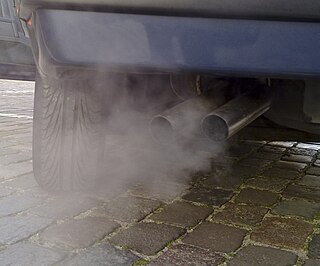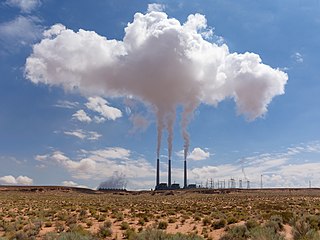Chevron U.S.A., Inc. v. Natural Resources Defense Council, Inc., 467 U.S. 837 (1984), was a landmark case in which the United States Supreme Court set forth the legal test for determining whether to grant deference to a government agency's interpretation of a statute which it administers. The decision articulated a doctrine now known as "Chevron deference". The doctrine consists of a two-part test applied by the court, when appropriate, that is highly deferential to government agencies: "whether the agency's answer is based on a permissible construction [emphasis added] of the statute", so long as Congress has not spoken directly to the precise issue at question.
Massachusetts v. Environmental Protection Agency, 549 U.S. 497 (2007), is a 5–4 U.S. Supreme Court case in which twelve states and several cities of the United States, represented by James Milkey, brought suit against the Environmental Protection Agency (EPA) to force that federal agency to regulate carbon dioxide and other greenhouse gases (GHGs) as pollutants.
United States vehicle emission standards are set through a combination of legislative mandates enacted by Congress through Clean Air Act (CAA) amendments from 1970 onwards, and executive regulations managed nationally by the Environmental Protection Agency (EPA), and more recently along with the National Highway Traffic Safety Administration (NHTSA). These standard cover common motor vehicle air pollution, including carbon monoxide, nitrogen oxides, and particulate emissions, and newer versions have incorporated fuel economy standards.
The environmental policy of the United States is a federal governmental action to regulate activities that have an environmental impact in the United States. The goal of environmental policy is to protect the environment for future generations while interfering as little as possible with the efficiency of commerce or the liberty of the people and to limit inequity in who is burdened with environmental costs. As his first official act bringing in the 1970s, President Richard Nixon signed the U.S. National Environmental Policy Act (NEPA) into law on New Years Day, 1970. Also in the same year, America began celebrating Earth Day, which has been called "the big bang of U.S. environmental politics, launching the country on a sweeping social learning curve about ecological management never before experienced or attempted in any other nation." NEPA established a comprehensive US national environmental policy and created the requirement to prepare an environmental impact statement for “major federal actions significantly affecting the quality of the environment.” Author and consultant Charles H. Eccleston has called NEPA, the world's “environmental Magna Carta”.

The Clean Air Act (CAA) is the United States' primary federal air quality law, intended to reduce and control air pollution nationwide. Initially enacted in 1963 and amended many times since, it is one of the United States' first and most influential modern environmental laws.
To protect the environment from the adverse effects of pollution, many nations worldwide have enacted legislation to regulate various types of pollution as well as to mitigate the adverse effects of pollution.

Air quality laws govern the emission of air pollutants into the atmosphere. A specialized subset of air quality laws regulate the quality of air inside buildings. Air quality laws are often designed specifically to protect human health by limiting or eliminating airborne pollutant concentrations. Other initiatives are designed to address broader ecological problems, such as limitations on chemicals that affect the ozone layer, and emissions trading programs to address acid rain or climate change. Regulatory efforts include identifying and categorizing air pollutants, setting limits on acceptable emissions levels, and dictating necessary or appropriate mitigation technologies.
American Electric Power Company v. Connecticut, 564 U.S. 410 (2011), was a United States Supreme Court case in which the Court, in an 8–0 decision, held that corporations cannot be sued for greenhouse gas emissions (GHGs) under federal common law, primarily because the Clean Air Act (CAA) delegates the management of carbon dioxide and other GHG emissions to the Environmental Protection Agency (EPA). Brought to court in July 2004 in the Southern District of New York, this was the first global warming case based on a public nuisance claim.
The, United States Environmental Protection Agency (EPA) began regulating greenhouse gases (GHGs) under the Clean Air Act from mobile and stationary sources of air pollution for the first time on January 2, 2011. Standards for mobile sources have been established pursuant to Section 202 of the CAA, and GHGs from stationary sources are currently controlled under the authority of Part C of Title I of the Act. The basis for regulations was upheld in the United States Court of Appeals for the District of Columbia in June 2012.
Entergy Corp. v. Riverkeeper, Inc., 556 U.S. 208 (2009), is a decision by the United States Supreme Court that reviewed the Environmental Protection Agency's (EPA) interpretation of the Clean Water Act regulations with regard to cooling water intakes for power plants. Existing facilities are mandated to use the "Best Technology Available" to "minimize the adverse environmental impact." The issue was whether the agency may use a cost–benefit analysis (CBA) in choosing the Best Available Technology or (BAT) to meet the National Performance Standards (NPS).

Mobile source air pollution includes any air pollution emitted by motor vehicles, airplanes, locomotives, and other engines and equipment that can be moved from one location to another. Many of these pollutants contribute to environmental degradation and have negative effects on human health. To prevent unnecessary damage to human health and the environment, environmental regulatory agencies such as the U.S. Environmental Protection Agency have established policies to minimize air pollution from mobile sources. Similar agencies exist at the state level. Due to the large number of mobile sources of air pollution, and their ability to move from one location to another, mobile sources are regulated differently from stationary sources, such as power plants. Instead of monitoring individual emitters, such as an individual vehicle, mobile sources are often regulated more broadly through design and fuel standards. Examples of this include corporate average fuel economy standards and laws that ban leaded gasoline in the United States. The increase in the number of motor vehicles driven in the U.S. has made efforts to limit mobile source pollution challenging. As a result, there have been a number of different regulatory instruments implemented to reach the desired emissions goals.

Energy Tax Prevention Act, also known as H.R. 910, was a 2011 bill in the United States House of Representatives to prohibit the United States Environmental Protection Agency (EPA) from regulating greenhouse gases to address climate change. On April 7, 2011, the bill passed the House by a vote of 255 to 172. The bill died in January 2013 with the ending of the Congressional session.
Environmental Defense v. Duke Energy Corporation, 549 U.S. 561 (2007), is a United States Supreme Court case in which the Court held that while a term may be used more than once in a statute, an agency has the discretion to interpret each use of the term in a different way based on the context. In a unanimous decision, the court held in favor of the plaintiff's argument.
Michigan v. Environmental Protection Agency, 576 U.S. 743 (2015), is a landmark United States Supreme Court case in which the Court analyzed whether the Environmental Protection Agency must consider costs when deciding to regulate, rather than later in the process of issuing the regulation.

The Clean Power Plan was an Obama administration policy aimed at combating anthropogenic climate change that was first proposed by the Environmental Protection Agency (EPA) in June 2014. The final version of the plan was unveiled by President Obama on August 3, 2015. Each state was assigned an individual goal for reducing carbon emissions, which could be accomplished how they saw fit, but with the possibility of the EPA stepping in if the state refused to submit a plan. If every state met its target, the plan was projected to reduce carbon emissions from electricity generation 32% by 2030, relative to 2005 levels, as well as achieving various health benefits due to reduced air pollution.
Reed v. Town of Gilbert, 576 U.S. 155 (2015), is a case in which the United States Supreme Court clarified when municipalities may impose content-based restrictions on signage. The case also clarified the level of constitutional scrutiny that should be applied to content-based restrictions on speech. In 2005, Gilbert, Arizona adopted a municipal sign ordinance that regulated the manner in which signs could be displayed in public areas. The ordinance imposed stricter limitations on signs advertising religious services than signs that displayed "political" or "ideological" messages. When the town's Sign Code compliance manager cited a local church for violating the ordinance, the church filed a lawsuit in which they argued the town's sign regulations violated its First Amendment right to the freedom of speech.
Expressions Hair Design v. Schneiderman, 581 U.S. ___ (2017), was a United States Supreme Court decision that held that price controls, when used to prohibit the communication of prices of goods with regards to a surcharge, was a regulation of speech and required an analysis of the First Amendment's protections for freedom of speech.
County of Maui v. Hawaii Wildlife Fund, No. 18-260, 590 U.S. ___ (2020), was a United States Supreme Court case involving pollution discharges under the Clean Water Act (CWA). The case asked whether the Clean Water Act requires a permit when pollutants that originate from a non-point source can be traced to reach navigable waters through mechanisms such as groundwater transport. In a 6–3 decision, the Court ruled that such non-point discharges require a permit when they are the "functional equivalent of a direct discharge", a new test defined by the ruling. The decision vacated the ruling of the United States Court of Appeals for the Ninth Circuit, and remanded the case with instructions to apply the new standard to the lower courts with cooperation of the Environmental Protection Agency (EPA).

The Institute for Policy Integrity is a non-partisan think tank housed within the New York University School of Law. Policy Integrity is dedicated to improving government decisionmaking, and its primary area of focus is climate and energy policy. Policy Integrity produces original scholarly research and advocates for reform before courts, legislatures, and executive agencies at both the federal and state level.
West Virginia v. Environmental Protection Agency is a pending United States Supreme Court case related to the Clean Air Act and the ability of the Environmental Protection Agency (EPA) to regulate carbon dioxide emissions related to climate change. The case centers on language of 42 U.S.C. § 7411(d), dealing with the EPA's authority to regulate emissions from existing power plants, which when amended and signed into law in 1990 mistakenly included contradictory language from both the House and Senate's version of the bill that never was reconciled, leaving the EPA to make its interpretation of this section.





